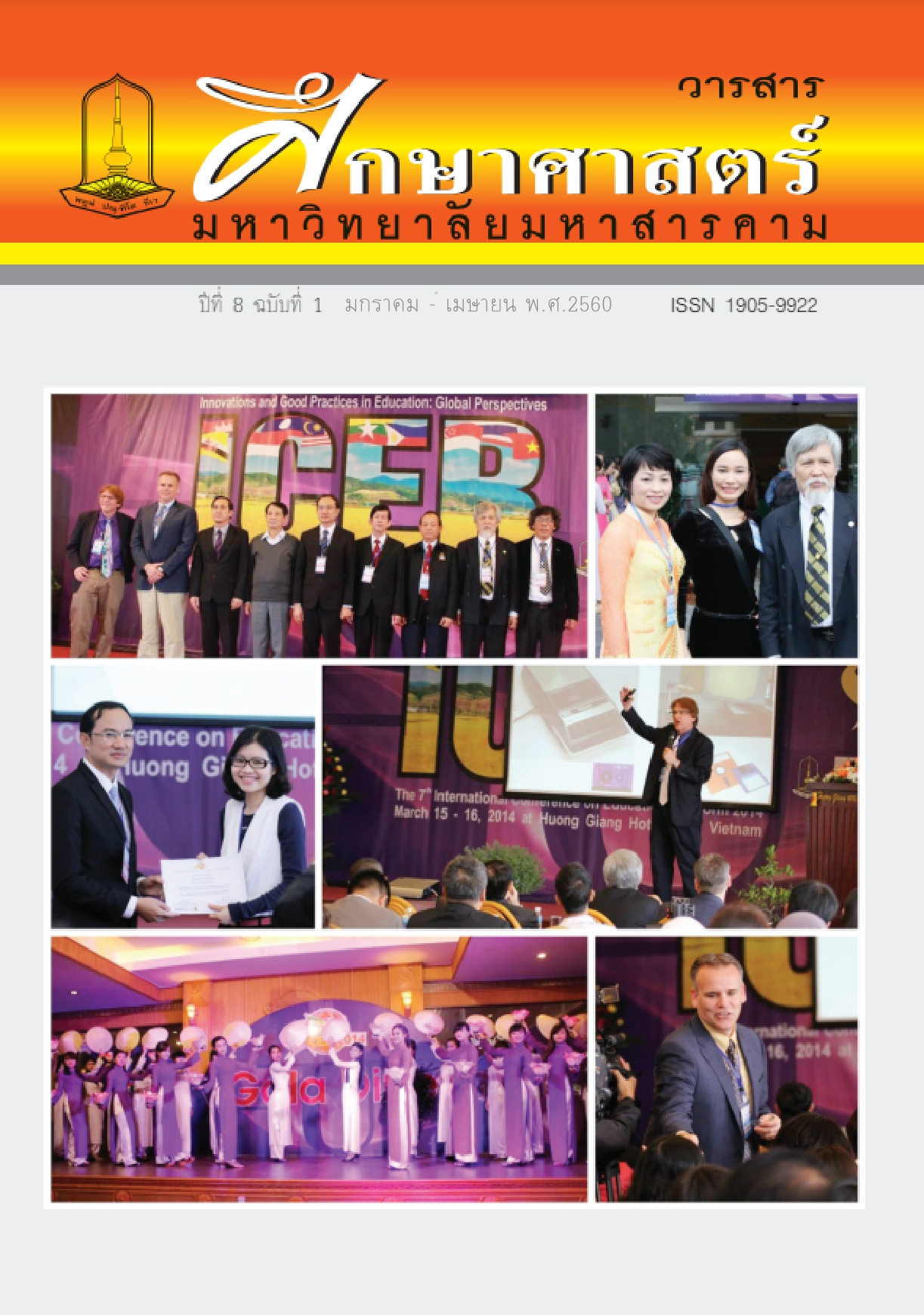Developing a Guideline to Strengthen Teacher Competency in Classroom Management for Educational Institution under the Jurisdiction of the Secondary Education Service Area 24
Main Article Content
Abstract
The purposes of this research were 1) to study the elements and indicators of teacher competency in classroom management for educational institutions. 2) to study the current state and the desirable state of teacher competency in classroom management for educational institution. 3) to develop a guideline to strengthen teacher competency in classroom management for educational institution. The samplings were 327 teachers of the Secondary Education Service Area 24. The samplings were chosen using Stratified Random Sampling. The research instruments used in this study were 1) a questionnaire with 5 levels rating scale and 2) a questionnaire and an evaluation of the suitability and possibility. Statistics used in the study were 1) percentage 2) average 3) standard deviation and 4) Correlation Coefficient
The findings showed that: 1. There were 6 elements and 25 indicators of teacher competency in classroom management for educational Institution under the Jurisdiction of the Secondary Education Service Area 24. 2. The current state of Teacher Competency in Classroom Management for Educational Institution under the Jurisdiction of the Secondary Education Service Area 24 was at a moderate level in all areas. When considering each dimension, it was found that the highest means were determining rules and regulations, classroom environment, and motivating learning atmosphere. Besides, the lowest mean was classroom activity. The desirable state of Teacher Competency in Classroom Managemen for Educational Institution under the Jurisdiction of the Secondary Education Service Area 24 was at the highest level at all areas. When considering each dimension, it was found that every dimension was at the highest level. 3. The developments of a guideline to strengthen Teacher Competency in Classroom Management for Educational Institution under the Jurisdiction of the Secondary Education Service Area 24 consisted of 1) 10 guidelines of teacher competency in classroom activity, 2) 7 guidelines of teacher competency in positive relationship, 3) 7 guidelines of teacher competency in determining rule and regulations, 4) 5 guidelines of teacher competency in motivating learning atmosphere, 5) 11 guidelines of teacher competency in classroom environment, and 6) 6 guidelines of teacher competency in providing information.
Downloads
Article Details
References
กระทรวงศึกษาธิการ. (2553). แนวทางการนำจุดเน้นการพัฒนาผู้เรียนสู่การปฏิบัติ. กรุงเทพฯ: องค์การค้ารับส่งสินค้าและพัสดุภัณฑ์.
คณะกรรมการการศึกษาขั้นพื้นฐาน. (2553). คู่มือการประเมินสมรรถนะครู สำนักงานคณะกรรมการการศึกษาขั้นพื้นฐาน พ.ศ. 2553. กรุงเทพฯ: สำนักงานคณะกรรมการการศึกษาขั้นพื้นฐาน.
ญาณภัทร สีหะมงคล. (2552). “การวิจัยและพัฒนา” ค้นคืนวันที่ 28 มีนาคม 2552 จาก http://www.ntc.ac.th/news/ntc_50/research/20/res
ประทวน มูลหล้า. (2552). ปัจจัยที่สัมพันธ์กับสมรรถนะการบริหารจัดการชั้นเรียนของครู ระดับมัธยมศึกษาช่วงชั้นที่ 3 ในสถานศึกษาสังกัดสำนักงานเขตพื้นที่การศึกษากรุงเทพมหานคร เขต 1. ปริญญานิพนธ์ กศ.ม. กรุงเทพฯ: มหาวิทยาลัยศรีนครินทรวิโรฒ.
พชรวิทย์ จันทรศิริสิร. (2554). การพัฒนาสมรรถนะทางการบริหาร. มหาสารคาม: มหาวิทยาลัยมหาสารคาม.
มะลิวัน สมศรี. (2558). การพัฒนาคู่มือพัฒนาสมรรถนะทางวิชาการของครูผู้สอนในสถานศึกษาสังกัด สำนักงานเขตพื้นที่การศึกษาประถมศึกษาอุดรธานี เขต 2. วิทยานิพนธ์ กศ.ม. มหาสารคาม: มหาวิทยาลัยมหาสารคาม.
เลขาธิการสภาการศึกษา. (2556). บทวิเคราะห์สถานภาพการพัฒนาครูทั้งระบบและข้อเสนอแนะแนวทางการพัฒนาครูเพื่อคุณภาพผู้เรียน. กรุงเทพฯ: บริษัทพริกหวานกราฟฟริค จำกัด.
วัชรีวรรณ ไชยแสนทา. (2550). การพัฒนาตัวชี้วัดประสิทธิภาพการบริหารจัดการชั้นเรียนสำหรับครูประจำชั้นระดับปฐมวัยศึกษา โรงเรียนวัดบางปะกอก กรุงเทพมหานคร. ปริญญานิพนธ์ กศ.ม. กรุงเทพฯ: มหาวิทยาลัยศรีนครินทรวิโรฒ.
วิสุทธิ์ เวียงสมุทร. (2553). การพัฒนารูปแบบการพัฒนาครูในการจัดการเรียนรู้ กลุ่มสาระ การเรียนรู้คณิตศาสตร์ ช่วงชั้นที่ 1-2. ปริญญาการศึกษาดุษฎีบัณฑิต. มหาสารคาม: มหาวิทยาลัยมหาสารคาม.
วัลลภา เทพหัสดิน ณ อยุธยา. (2544). การพัฒนาการเรียนการสอนทางการอุดมศึกษา. กรุงเทพ: จุฬาลงกรณ์มหาวิทยาลัย.
สมหวัง มหาวัง. (2554). การพัฒนาหลักสูตรฝึกอบรมเพื่อเสริมสร้างสมรรถนะครูด้านการบูรณาการภูมิปัญญาท้องถิ่นในหลักสูตรสถานศึกษาขั้นพื้นฐาน. วิทยานิพนธ์ กศ.ด. มหาสารคาม: มหาวิทยาลัยมหาสารคาม.
สำนักงานเขตพื้นที่การศึกษามัธยมศึกษา เขต 24. (2557). แผนปฏิบัติการประจำ ปี 2559. กาฬสินธุ์: สำนักงานเขตพื้นที่การศึกษามัธยมศึกษา เขต 24.
Etheridge, Tasha R. (2010). Assertive Discipline and its Impact on Disruptive Behavior. Minnesota: Capella University.
Gilpatrick, Robin Sue Holzworth. (2010). Classroom Management Strategies and BehavioralInterventions to Support Academic Achievement. Minnesota: Walden University.


